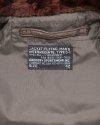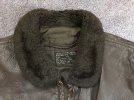Lord Flashheart
Well-Known Member
11. MIL-J-7823D (WP) [1967 - 1971]
The 7823D (WP) is a controversial specification. Starting in 1967, it was produced until 1971. For 1967 - mid-1969, the 7823D (WP) specification was made from USN chrome-tanned seal brown goatskin with real mouton fur collars. However, sometime in mid 1969, the 7823D specification was amended to allow for faux mouton collars (80% Dynel, 20% cotton) and cowhide to be used instead. However, all 7823Ds retained double-ply no rib rack 100% wool knits. The possible combinations for 7823D G-1s are thus as follows: goatskin with real mouton, goatskin with Dynel collar, or cowhide with Dynel. Surprisingly, however, no cowhide and real mouton versions have been documented.
The 7823D (WP) is a controversial specification. Starting in 1967, it was produced until 1971. For 1967 - mid-1969, the 7823D (WP) specification was made from USN chrome-tanned seal brown goatskin with real mouton fur collars. However, sometime in mid 1969, the 7823D specification was amended to allow for faux mouton collars (80% Dynel, 20% cotton) and cowhide to be used instead. However, all 7823Ds retained double-ply no rib rack 100% wool knits. The possible combinations for 7823D G-1s are thus as follows: goatskin with real mouton, goatskin with Dynel collar, or cowhide with Dynel. Surprisingly, however, no cowhide and real mouton versions have been documented.
| SPECIFICATION MIL-J-7823D (WP) | Contract dates | [Source]/Links/Comments |
| STAR SPORTSWEAR MFG. CORP. DSA 100-67-C-1095 | 1967 | Specification still listed as (WEP) |
| GREGORY SPORTSWEAR, INC. CONTRACT NO. DSA-100-67-C-3928 | 1967 | Specification still listed as (WEP) https://www.vintageleatherjackets.o...rmediate-flying-jacket-mil-j-7823d-wep.26641/ |
| THE MARTIN LANE CO., INC. DSA 100-68-C-0099 | 1968 | |
| STAR SPORTSWEAR MFG. CORP. DSA 100-68-C-0759 | 1968 | |
| BRILL BROS., INC. DSA 100-68-C-1805 | 1968 | https://www.vintageleatherjackets.o...pe-g-1-intermediate-flying-jacket-uscg.25648/ |
| STAR SPORTSWEAR MFG. CORP. DSA 100-69-C-1095 | 1969 | |
| THE MARTIN LANE CO., INC. DSA 100-69-C-1545 | 1969 | |
| STAR SPORTSWEAR MFG. CORP. DSA 100-70-C-0475 | 1970 | |
| BRILL BROS., INC. DSA 100-70-C-0484 | 1970 | |
| STAR SPORTSWEAR MFG. CORP. DSA100-70-C-0483 | 1970 | |
| BRILL BROS., INC. DSA 100-71-C-0141 | 1971 | |
| STAR SPORTSWEAR MFG.CO. DSA100-71-C-0535 | 1971 |
Last edited by a moderator:


